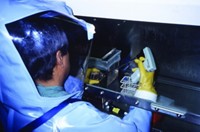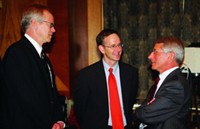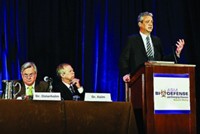Advertisement
Grab your lab coat. Let's get started
Welcome!
Welcome!
Create an account below to get 6 C&EN articles per month, receive newsletters and more - all free.
It seems this is your first time logging in online. Please enter the following information to continue.
As an ACS member you automatically get access to this site. All we need is few more details to create your reading experience.
Not you? Sign in with a different account.
Not you? Sign in with a different account.
ERROR 1
ERROR 1
ERROR 2
ERROR 2
ERROR 2
ERROR 2
ERROR 2
Password and Confirm password must match.
If you have an ACS member number, please enter it here so we can link this account to your membership. (optional)
ERROR 2
ACS values your privacy. By submitting your information, you are gaining access to C&EN and subscribing to our weekly newsletter. We use the information you provide to make your reading experience better, and we will never sell your data to third party members.
Policy
Congress Steps Into H5N1 Research Controversy
Dual-Use Research: Fears of NIH-funded work prompts congressman to demand answers about safeguards from the Administration
by William G. Schulz
March 2, 2012
The saga of the experimental H5N1 avian flu research that has stirred so much controversy in recent weeks has taken yet another turn. Now, Rep. F. James Sensenbrenner Jr. (R-Wis.), vice chair of the House Committee on Science, Space & Technology, has begun an investigation of how such research might be affecting national security.
“The Administration’s response has appeared ad hoc, delayed, and inadequate,” Sensenbrenner wrote in a March 1 letter to White House Science Advisor John P. Holdren. He questioned whether the research should have been done at all, skewered the NIH review system that did not flag it for biosecurity concerns until the work was near publication, and demanded to know how the National Science Advisory Board for Biosecurity (NSABB), a federal advisory panel, works to weigh the risks and benefits of dual-use research before making recommendations regarding research publication.
Sensenbrenner also asked about government mechanisms to handle research data of dual-use concern when it is to be published—that is, by redacting sensitive information from public availability yet still making relevant data available to “legitimate scientists who need it.”
No such mechanism exists for federally funded scientific research. Science Editor-in-Chief Bruce M. Alberts requested in early February that the government present such a mechanism before he would agree to publish a redacted version of one of the H5N1 research papers in question. None has been forthcoming, and it is widely acknowledged that NSABB and federal agencies involved in evaluating scientific research of dual-use concern have failed thus far to create such a mechanism.
But the potential of a global H5N1 pandemic that would wreak death on an unprecedented scale in world history—a scenario promulgated by members of NSABB, Sensenbrenner , and many others—has been challenged by Ron A. M. Fouchier, a principle investigator for one of the H5N1 research projects involving ferrets as a human model.
Fouchier, revealing new details of his work, told a packed audience at a meeting of the American Society for Microbiology on Feb. 29: “The mutated virus only causes disease in one out of eight animals infected and only in high doses.” He said that many ferrets in his experimental work show no symptoms at all and that when the ferrets have also been exposed to seasonal flu, they have extra protection against the H5N1 infection.
“If you ask me if this work should be done,” Fouchier told the audience, “my answer would be yes.”





Join the conversation
Contact the reporter
Submit a Letter to the Editor for publication
Engage with us on Twitter